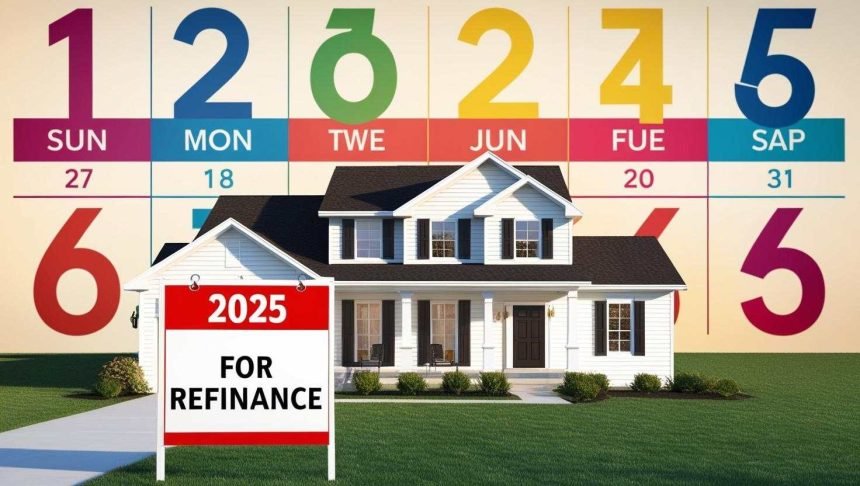Mortgage refinancing is an important way to manage your money because it can help you save money, combine your debts, or change the terms of your loan as your needs change.
Rates for refinancing have been going up and down over the past few years, but 2025 will bring new chances for some users to benefit from the process.
This detailed guide will talk about who should think about refinancing right now, the different kinds of refinancing, and steps that can be taken to make the process go more smoothly.
Why Consider Mortgage Refinancing in 2025?
In 2023 and 2024, mortgage rates averaged between 6.08% and 7.79%. These rates are higher than the all-time lows during the pandemic, but they are better than recent high points.
Many homeowners see refinancing as a way to get better terms on their loan, lower their monthly payments, or reach other personal financial goals.
Christy Bunce, president of New American Funding, says, “Mortgage rates are still higher than they were at their all-time low, but they are now better than they were at their most recent high, giving homeowners smart chances to refinance.”
You can tell if refinancing is right for you by looking at your present mortgage and your financial goals.
4 Types of Borrowers Who Should Refinance Now
Mortgage experts have identified four key borrower profiles that stand to benefit significantly from refinancing in the current market.
1. Adjustable-Rate Mortgage (ARM) Borrowers Facing Adjustments
You can avoid rate hikes if you refinance to a fixed-rate mortgage if your 5/1 ARM is getting close to its adjustment period.
Liz Bryant, who is in charge of an area for Citi, says that borrowers with better credit or less debt can especially benefit.
Many ARMs that were given in late 2019 had rates that started at about 3.4%, but rates could now be raised by three points, which would make monthly payments much higher.
2. Recent Buyers with Rates Above 7%
Homeowners who locked in rates exceeding 7% over the past two years could achieve substantial savings by refinancing now.
Even a small rate drop of 0.5% to 1% can save you hundreds of dollars a month and a lot of money in interest over the life of the loan.
But make sure you look at the closing costs to make sure you’ll be better off in the long run.
3. Homeowners Paying Private Mortgage Insurance (PMI)
If your home equity has grown because of steady mortgage payments or rising property values, you may be able to get rid of PMI by refinancing.
There may be a small increase in the interest rate, but the total savings from getting rid of PMI usually outweigh this.
4. Borrowers Seeking Cash-Out Refinancing
With a cash-out refinance, you can combine debts with high interest rates, like credit card balances, into a single mortgage payment with a lower interest rate.
This choice may make your mortgage rate go up, but it can also lower your monthly payments by a lot, giving you more money for other things.
Related: Don’t Buy a Home Without Knowing These Key Mortgage Facts
Understand the Types of Mortgage Refinancing
Refinancing is not a one-size-fits-all solution. Selecting the right type depends on your financial goals, eligibility, and current loan terms. Here are the most common refinancing options:
1. Rate-and-Term Refinancing
This is the most popular form of refinancing, allowing homeowners to secure a new interest rate or repayment schedule. By refinancing to a lower rate, you can reduce your monthly payments or pay off your mortgage faster.
- Requirements:
- Credit Score: Minimum 620
- Debt-to-Income Ratio (DTI): 36%-50%
- Home Equity: At least 20%
2. Streamline Refinancing
Designed for government-backed loans like FHA, USDA, or VA mortgages, streamline refinancing simplifies the process by eliminating appraisals and reducing paperwork. This option is ideal for borrowers seeking lower rates or payments without major upfront costs.
- Eligibility:
- On-time payments for 6-12 months
- Positive financial impact from refinancing
3. Cash-Out Refinancing
Homeowners can leverage their home equity to access cash while replacing their existing mortgage with a larger loan. This option is suitable for consolidating debts or funding major expenses.
- Requirements:
- Credit Score: Minimum 620
- DTI: 36%-50%
- Home Equity: Typically 20%
4. Cash-In Refinancing
With a cash-in refinance, borrowers pay down a significant portion of their loan at closing, resulting in a smaller loan balance with potentially better terms. This approach is useful for dropping PMI or securing lower interest rates.
5. Reverse Mortgage
Reserved for older homeowners, reverse mortgages enable borrowers to convert home equity into cash without monthly payments. While appealing for some, these loans come with risks, including the potential for heirs to inherit debt obligations.
6. Short Refinancing
Lenders may allow struggling homeowners to refinance at a reduced loan balance to avoid foreclosure. However, this option can severely impact credit scores and may involve tax implications.
7. No-Closing-Cost Refinancing
To reduce upfront costs, some lenders offer no-closing-cost refinancing, which rolls fees into the loan balance. While convenient, this increases your monthly payment slightly.
Factors to Consider Before Refinancing
Refinancing can offer substantial benefits, but it’s essential to weigh the following considerations:
- Break-Even Point Determine how long it will take to recoup closing costs through monthly savings. Refinancing typically makes sense if you plan to stay in your home for at least 2-3 years.
- Closing Costs Expect to pay 2%-5% of the loan amount in closing fees. Compare these costs against potential savings to ensure a net benefit.
- Loan Progress Refinancing later in your mortgage term may not yield significant savings, as much of the interest has already been paid.
- Rate Difference Mortgage officer Dean Rathbun recommends refinancing only if you can achieve a rate reduction of at least 0.75%, ideally with a no-points loan to minimize upfront costs.
- Future Rate Changes If rates are expected to drop further, you can refinance again after six months. Discuss this strategy with your lender.
How to Choose the Right Refinancing Lender
Selecting the right lender is crucial to a successful refinancing experience. Consider these factors:
- Cost: Compare sample rates and lender fees from multiple providers to find the most competitive offer.
- Eligibility Requirements: Ensure you meet the lender’s credit, DTI, and home equity standards.
- Customer Service: Research lender reviews and rankings, such as J.D. Power’s satisfaction surveys.
- Timeline: The average refinancing process takes 44 days. Verify the lender’s processing speed and communication practices.
The Bottom Line
Many homeowners might find it smart to refinance their mortgage in 2024, especially if their rates are going to change, they have high-interest debts, or they have to pay PMI.
You can save a lot of money and get more financial freedom by carefully looking at your present loan terms, your financial goals, and your eligibility.
Now is the time for U.S. homeowners to talk to a reputable mortgage agent.
They can help you look at your refinancing options, figure out how much you might save, and get through the whole process.
Refinancing could be the key to financial peace of mind for you, whether you want lower monthly payments, to consolidate your debt, or to get a new loan structure.





